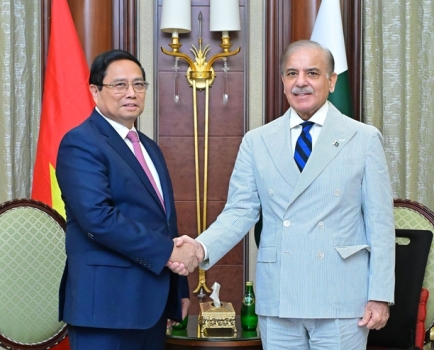A shared visa zone for the Southeast Asia region, similar to Europe’s Schengen visa mechanism, could be a game-changer Vietnam’s tourism sector needs. The proposed “Six Countries, One Destination” initiative aims to facilitate seamless travel across six neighboring countries, thus boosting regional tourism.
On the sidelines of the 44th and 45th ASEAN Summits in Laos on October 9, Vietnamese Prime Minister Pham Minh Chinh his Thai counterpart Paetongtarn Shinawatra agreed to pilot the tourism initiative, that involves Thailand, Maylasia, Singapore, Vietnam, Laos and Cambodia.
Originally proposed by Thailand in April 2024, this visa plan will allow tourists to travel freely between six countries in the region, supercharing the local tourism industry. Thailand even hopes to negotiate visa-free travel between these ASEAN nations and the European Union’s Schengen zone.
Vietnam had floated a similar idea 14 years ago including five countries covering the Mekong sub-region, including Vietnam, Cambodia, Laos, Myanmar, and Thailand, but nothing came of it.
Nguyen Quoc Ky, Chairman of Vietravel Corporation, who first proposed the concept, emphasised the importance of acting quickly in the current tourism landscape. After the pandemic, tourism markets have opened up, and countries that act fast can capture the growing demand.
He pointed out that countries like Thailand, Malaysia, and Singapore have been swift in implementing open visa policies. While Vietnam reopened early after the pandemic, its tourism policies have been slower to evolve. Currently, Vietnam offers visa exemptions to citizens of 26 countries, far fewer than Thailand’s nearly 100.
If the six countries' initiative is implemented quickly, Vietnam can leverage the open policies of its neighbours to attract a large number of international tourists, he said.
Additionally, joint promotion efforts with the five other countries would provide greater reach compared to Vietnam acting alone. However, Vietnam still lacks an official tourism promotion office abroad, putting it at a disadvantage in international marketing.
Implementing this shared visa system will significantly benefit Vietnam’s tourism. By 2050, the Asia-Pacific region is expected to dominate global tourism, with Southeast Asia as a key destination. Vietnam must act quickly to capitalise on this opportunity and strengthen its position in the regional tourism race. However, experts warned that a shared visa policy could also increase competition among the six countries.
Cao Tri Dũng, Chairman of the Da Nang Tourism Association, noted that while the visa policy could expand the tourism market for ASEAN, it would also intensify competition. The countries will compete to attract visitors, and those with less attractive destinations can lose out.
Dung stressed the need for Vietnam to prepare high-quality, unique tourism products to ensure tourists stay longer and spend more.
Ky emphasised the need to highlight Vietnam’s distinct cultural offerings as tourists are seeking diverse cultural experiences. Vietnam must showcase its unique traditions, cuisine, and everyday life to stand out, he noted.
Additionally, Vietnam's diverse climate, ranging from temperate to tropical zones, offers tourists a variety of experiences in a single trip - an advantage few countries can match.
To stay competitive, Ky called for immediate research on the key tourist markets of the six countries and an analysis of their products to ensure Vietnam can offer something distinct.
The “Six Countries, One Destination” visa presents Vietnam with a unique chance to transform its tourism sector, but success will depend on how quickly and effectively the country prepares to cope with the challenges./.














